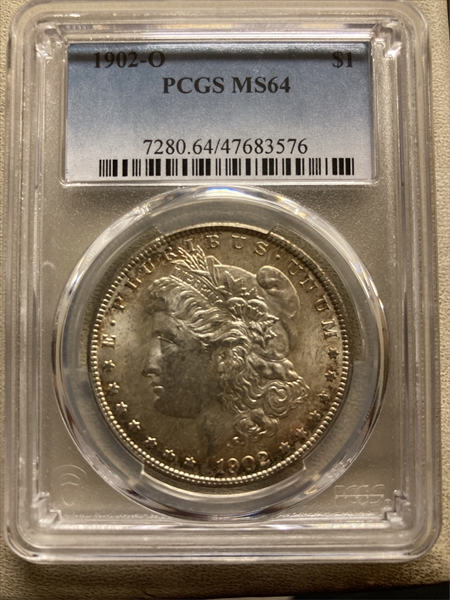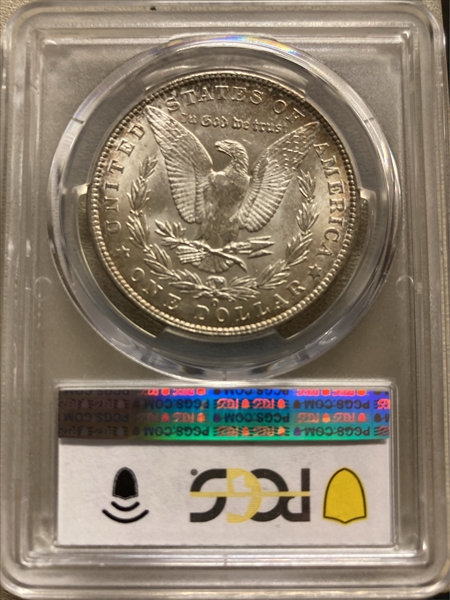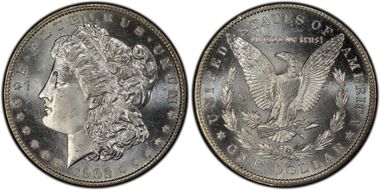1902-O $1 MS64 认证号47683576, PCGS号7280
专家评论
Ron Guth
In 2005, PCGS determined that all 1896-O, 1900-O and 1902-O Silver Dollars with so-called "Micro o" mintmarks were counterfeit. This announcement was based on the discovery that all three dates shared common die markers.Q. David Bowers
The following narrative, with minor editing, is from my "Silver Dollars & Trade Dollars of the United States: A Complete Encyclopedia" (Wolfeboro, NH: Bowers and Merena Galleries, Inc., 1993)Numismatic Information
Hoard coins: Although 1902-O dollars seeped out over a period of years from storage in the Treasury Building in Washington, D.C., especially in the late 1950s and very early 1960s (before autumn 1962), the date was not considered common until a vast torrent of hundreds of thousands emerged from a sealed vault in the Philadelphia Mint in October 1962 and ensuing months. Earlier, the 1902-O was considered to be a rarity in Mint State, and for a period of years it was priced higher than, for ex-ample, the 1884-S.
Circulated grades: Today, the 1902-O is slightly scarce in worn grades. However, it sells for little more than a common date. The depressed valuation for circulated coins is due to the widespread availability of Uncirculated pieces.
Mint State grades: In Uncirculated grades the 1902-O is very common. Most are in lower levels, but enough MS-64 and MS-65 coins exist that little effort is required to locate a specimen. I estimate that 300,000 to 600,000 survive at the MS-60 to 62 level, 125,000 to 250,000 in MS-63, 100,000 to 200,000 in MS-64, and 14,000 to 28,000 MS-65s.
The striking quality of 1902-O dollars is usually poor, with flatness at the centers, particularly the reverse. Lustre ranges from dull to "greasy" on most pieces. There are exceptions, as might be expected from such a large coinage, and diligent cherry-picking may yield a sharply struck, lustrous coin at, who knows, perhaps for not much more money than a flat strike.
Prooflike coins: Wayne Miller wrote that the issue was believed to be elusive, until one or two bags of Prooflike pieces came on the market in 1968. Unfortunately, these coins lacked satisfactory contrast and were gray in appearance, which seems to be par for the course for prooflikes of this date. Most of these coins have long since been absorbed into collections. Probably 5,000 to 10,000 PL coins exist. DMPL coins are about four or five times harder to find than PL. Apparently, high-contrast cameo DMPL coins are unknown.
Varieties
NEW OVER OLD HUB: DOUBLE OLIVE AT CLAW
1. C-4 reverse hub over C-3: Breen-5692, VAM-8, 12, 15-21, 23, 25, 27-32, 34-39. Reverse die variations differ from each other minutely. An outstanding example of a cluster of varieties of a major type relatively unknown as recently as 20 years ago, but now considered common.
VAM C-4 OVER C-3 REVERSE
Circulation strikes:
NEW REVERSE HUB: WIDE NECK/WING SPACE, LARGESTARS
Circulation strikes:
1. Medium O. Breen-5691, VAM 1-2,4-11, others, mostly positional varieties. Many survive from the huge Treasury releases of this date.
Evidently most of the 140 obverses, 107 reverses intended for 1902-O (various hub types combined) were unused.
Dies prepared: Obverse: 140; Reverse: 107 Circulation strike mintage: 8,636,000; Delivery figures
by month: January: 1,500,000; February: 750,000; March: 750,000; April: 500,000; May: 1,000,000; June: 320,000; July: 550,000; August: 1,000,000; September: 1,200,000; October: 500,000; November: 500,000; December: 66,000.
Estimated quantity melted: Millions, probably starting with the 1918 Pittman Act authorization.
Availability of prooflike coins: Relatively common.
A bag or two of prooflikes came on the market in 1965. About 5,000 to 10,000 exist (URS-14). DMPL coins are scarcer.
Characteristics of striking: Usually very poor, but there are rare exceptions.
Known hoards of Mint State coins: Many hundreds of bags were released by the Treasury 1962-1964. These were in addition to bags released earlier.
Commentary
The 1902-O is very plentiful in flatly struck, low Uncirculated grades.
Additional Information
Status of the New Orleans Mint
The Annual Report of the Director of the Mint, 1902, discussed the New Orleans Mint:
"The increased capacity of the mints at Philadelphia and San Francisco and the prospective opening of the new mint at Denver have provided and will provide a much greater coinage capacity than the country has heretofore had. On the other hand, the pressure upon the mints will relax rather than increase. The coinage of 1.5 million silver dollars per month, now required bylaw, will soon come to an end by the exhaustion of the stock of bullion purchased under the Act of July 14, 1890. This requirement now calls for a coinage equal to the entire capacityof the New Orleans Mint.
"When it ceases, that mint will be idle unless work is diminished at Philadelphia and San Francisco to give it employment. When the Denver Mint is opened, the bullion output of Colorado and possibly of other mining districts of the West now going to Philadelphia will be cut off from the latter institution, and it does not seem advisable to still further reduce its operations in order to supply work for New Orleans. The operations of the San Francisco Mint are wholly confined to gold produced or imported on the Pacific coast and the manufacture of the subsidiary coins required in the Pacific coast states, and it is not practicable to divide its work with the mint at New Orleans.
"The latter institution was reopened after the civil war in 1879, and since then has been almost wholly employed upon the coinage of silver. Its receipts of gold are small-last year about $400,000-and alone do not warrant coinage operations. It would be a useless and unjustifiable expense to ship gold bullion from Denver, Philadelphia, or any other of the offices of the service, to New Orleans for coinage, as the Treasury would have no use for the coin there.
"It is opportune here to call attention to the fact that the gold coinage of the country is now entering almost entirely into storage and that the cost of coinage is an unnecessary expense. The Treasury holds now about $500 million of coined gold, which is doubtless more than will be called for in a generation to come. Practically all of the current coinage is being deposited ii the Treasury for certificates. When gold is required for export, it is wanted in bars, while for domestic circulation the public prefers the Treasury certificates, which, with some modification of the statutes, might as well be issued against bars.
"The balance of silver bullion purchased under the Act of 1890, in the Treasury July 1, 1902, was 33,218,712 fine ounces. The amount of this bullion used in last year's coinage operations was 19,344,209 ounces, so that if the same amount is used in the current fiscal year the amount remaining on July 1, 1903, will be only 18,874,903 ounces, which is not enough to allow of a full year's coinage for all the mints in 1903-1904. This bullion is all at Philadelphia, and, inasmuch as that mint can easily meet all requirements, it is not considered advisable to ship any bullion from there to New Orleans after July 1 next, or to plan for coinage operations at the latter place after that date.
"The cost of operating the New Orleans Mint last year was $259,158.98. The estimates for Philadelphia and San Francisco are not increased, but it will be possible for those institutions to do the entire coinage for the year 1903-1904 within the appropriations that are asked for them. On the other hand, if the work to be done is divided between the three mints, it will not be possible to make any considerable reduction in expenditures, as a complete organization of skilled employees must be kept at each establishment.
"If coinage operations are now discontinued at New Orleans, so much of the machinery there as is in good condition and of approved design can be transferred to the new Denver Mint, and the estimates for equipment there correspondingly reduced.
"If the New Orleans institution is abolished, the country will be left with three coinage mints-one on the Pacific coast, which will be the natural depository of the gold product of Alaska and the Pacific coast States and of the imports from Australia and the Orient; one in the interior, convenient to the gold producers of the Rocky Mountain region; and one near the eastern coast, convenient to receive the imports from that direction. This may be accepted as a satisfactory permanent arrangement."
The above proposal to end coinage at New Orleans ignored the large dollar coinages at San Francisco, did not plan for later 0 and S mint subsidiary silver, and did not succeed until 1909.
Distribution of Dollars
The Annual Report of the Director of the Mint, 1902, told of the distribution of dollars during the fiscal year: New Orleans:
In mint June 30, 1901, 15,823,500; coinage, fiscal year 1902, 10,770,000; total, 26,593,500; in mint June 30, 1902, 18,033,000; distributed from mint, 8,560,500.
PCGS #
7280
设计师
George T. Morgan
边缘
Reeded
直径
38.10 毫米
重量
26.73 克
铸币数量
8636000
金属成分
90% Silver, 10% Copper
更高评级数量
8249
评级较低的钱币数量
33428
地区
The United States of America
价格指南
PCGS 数量报告
拍卖 - PCGS 评级的
拍卖 - NGC 评级的
稀有性和存量估计 了解更多
| 所有评级 | 864000 |
| 60或以上 | 55000 |
| 65或以上 | 16000 |
| 所有评级 | R-1.2 |
| 60或以上 | R-2.4 |
| 65或以上 | R-2.8 |
| 所有评级 | 81 / 117 TIE |
| 60或以上 | 52 / 117 TIE |
| 65或以上 | 93 / 117 TIE |
| 所有评级 | 81 / 117 TIE |
| 60或以上 | 52 / 117 TIE |
| 65或以上 | 93 / 117 TIE |

























